BRENDA FITZSIMONS
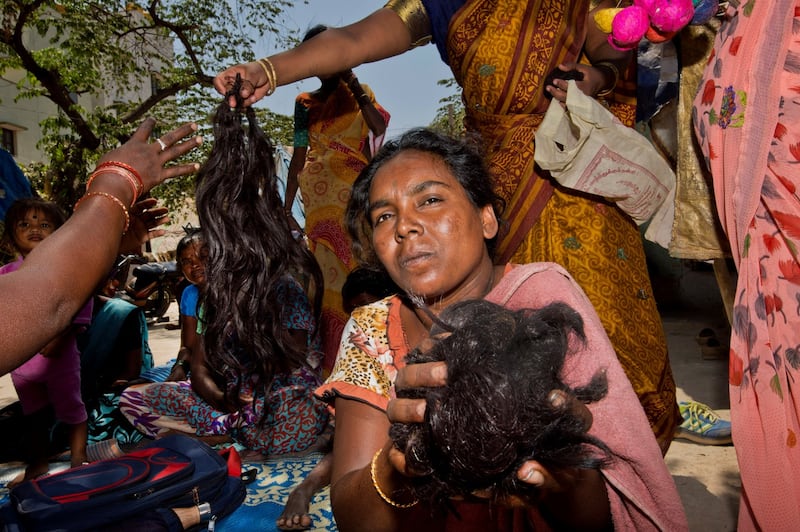
I took this photograph in the TC Palya slum in Bangalore, in India, earlier this year. Rosita Boland, the Irish Times features writer, and I were investigating the origins of a multibillion-euro industry: the collection of human hair for resale as wigs and hair extensions in the salons of the West. These women had been out collecting hair from the brushes and combs of women in ordinary households.
Depending on how much hair is collected from each home, a small item is given in exchange, such as a hair clip or a tin cup. Back in the slum, the hair is then washed and sorted, and sold on within the slum, to men called aggregators. A kilo of hair sold in a slum makes €31. By the time it reaches the West, its price has soared to €3,000.
The woman in this picture is named Gangamma. She was sorting hair that she and other women had recently collected.
It was important to light the women's faces properly and highlight the colours of their sarongs. The hair, which was central to the story, had to be prominent, too, and carefully lit
I gave myself time to watch the women work before taking my camera out of my bag. There is little time to shoot in such searing heat. Digital cameras have a tendency to just shut down, and battery life can also significantly reduce. The first signs are when none of the camera readings make sense even though they are set manually: it’s an awful feeling and very difficult to remedy in a location where there is no electricity. With the sun high in the sky, it was obvious that I would need a flash and that I had to work quickly.
I’m usually reluctant to use flash, because it’s distracting to the person being photographed. In this case it was important that I light their faces properly and highlight the colours of their sarongs. The hair, which was central to the story, had to be prominent in the image, and carefully lit.
I was lucky. I got this shot just before my camera shut down from overheating.
DARA MAC DÓNAILL
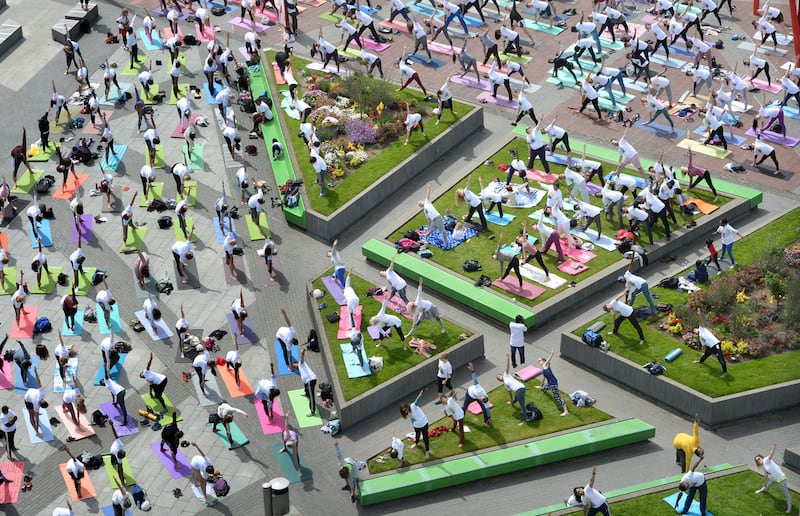
This event at Grand Canal Square, in Dublin on June 22nd was held to celebrate International Yoga Day. Organised by the Indian embassy and Dublin City Council, it attracted young and old, families, yoga beginners and seasoned enthusiasts, including Sabina Higgins.
In this photograph the trikonasana yoga pose seems to be in sync with the angular ground shapes, in a pleasing combination of colours and shapes
I was told about the event the previous day. Knowing that the surface they’d be using had contrasting shapes and colours, I thought an aerial shot might work, the colourful mats and variety of yoga poses producing an interesting photograph.
My colleague Shay, on the picture desk, asked the Marker Hotel, which overlooks Grand Canal Square, if I could take some of the photographs from its building, which it kindly agreed to.
On the day I shot a range of images at ground level and from a nearby stage – and in my final edit decided that the aerial shots were indeed the most striking. In this photograph the trikonasana yoga pose seems to be in sync with the angular ground shapes, in a pleasing combination of colours and shapes.
BRYAN O’BRIEN
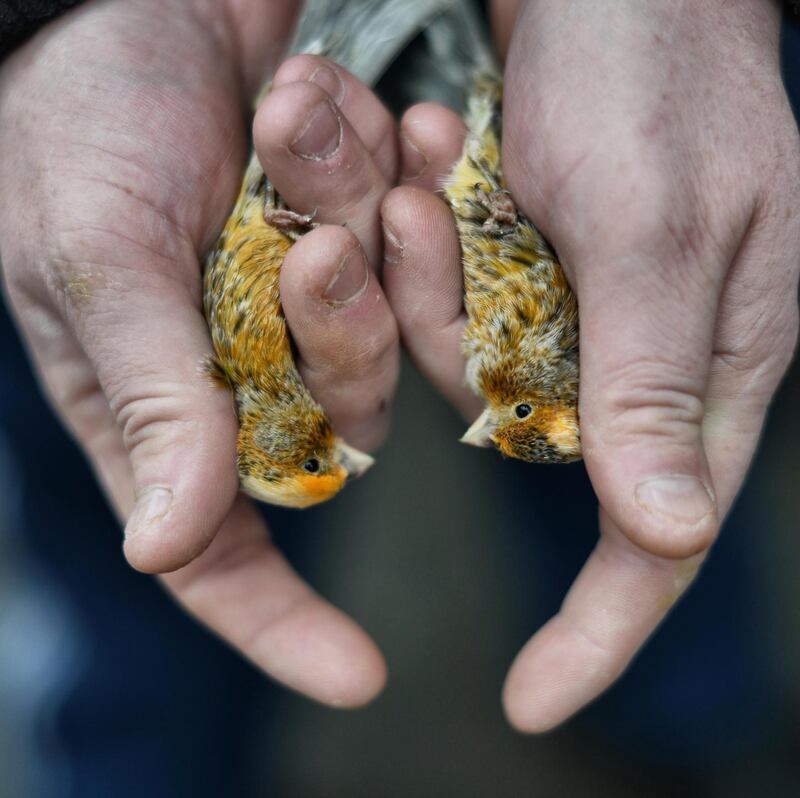
Noel is a bird collector and breeder from Ballyfermot in Dublin. In this photograph he is holding a pair of finches, to show them to a prospective buyer at weekly Peter Street bird market, between St Patrick’s Cathedral and Aungier Street, in the middle of Dublin.
There's something interesting about burly men handling tiny, gentle, fragile creatures: goldfinches, chaffinches, budgies and canaries. There are nice sounds also, lots of birdsong and banter
Early every Sunday morning, bird enthusiasts gather here with cages full of birds, to show and sell the little creatures, along with bird food and accessories. It’s mainly men, and everyone seems to know everyone else. Many older patrons have been coming since they were boys.
I’ve always found the market interesting; the bright colours of the exotic birds contrasts with the greyness of the surroundings. There’s something interesting about burly men handling tiny, gentle, fragile creatures: goldfinches, chaffinches, budgies and canaries. There are nice sounds also, lots of birdsong and banter. It’s always fun to listen to a buyer haggling with a seller.
It only lasts for a couple of hours; people come for different reasons: to sell and buy, to show birds, and to just meet up with friends who share an interest. People are proud of their birds, and not at all afraid to show them to tourists and visitors alike.
ALAN BETSON
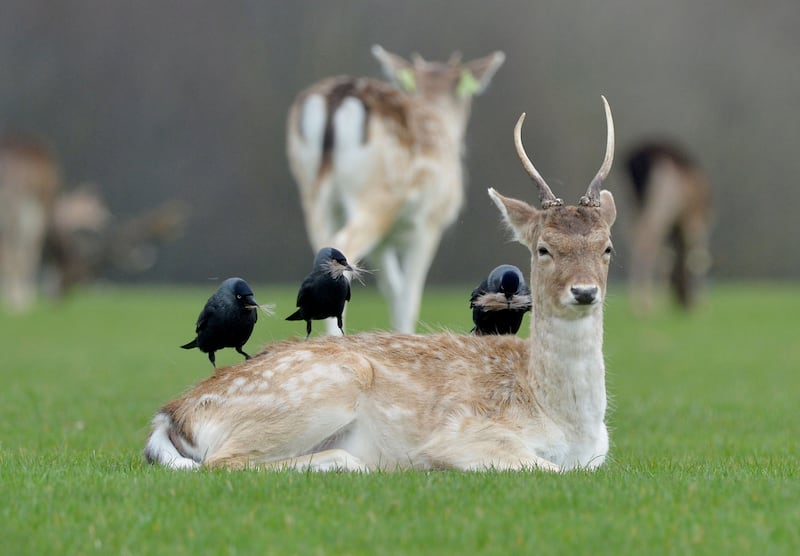
The Phoenix Park deer are the photographic gift that just keep on giving. Rutting season, fawning season, culling season... The life cycle of Europe’s best-maintained herd reveals another fascinating side to their charmed existence in Europe’s largest walled city park.
A photographically quiet March inevitably leads me to the park in the daily search for standalone pictures. Duelling stags locked in combat catch my eye, but this picture has been seen before, many times over. I notice the stags also duelling with the static football posts. The decimated paintwork on the first metre of the goalpost reveals the habitual sloughing of antlers. But it still doesn’t make a picture.
I notice the crows. I see one strangely perched on a deer, which I think odd as a place to rest. Then I see it: peck, peck, peck and a mouthful of fur. Aha! My Attenborough stirs
Then I notice the crows. I see one strangely perched on a deer, which I think odd as a place to rest. Then I see it: peck, peck, peck and a mouthful of fur. Aha! The inner Attenborough stirs inside me.
The deer is completely indifferent to the pecking cling-ons. I crouch in sniper mode with my long 500mm lens, but it is still not enough to fill the frame. As I edge closer, the herd stir. Therein lies the dilemma: too close and nature will be disturbed, so the herd will scatter and all will be lost; but too far away and the detail is too small to see.
And so a gentle edging forward, avoiding the patches of deer poo, combined with patience, captures one crow, then two and, finally, with breath held, three crows, helping themselves to the finest deer fur, presumably to line the interior of their nests for the next stage in their own life cycle.
ENDA O’DOWD
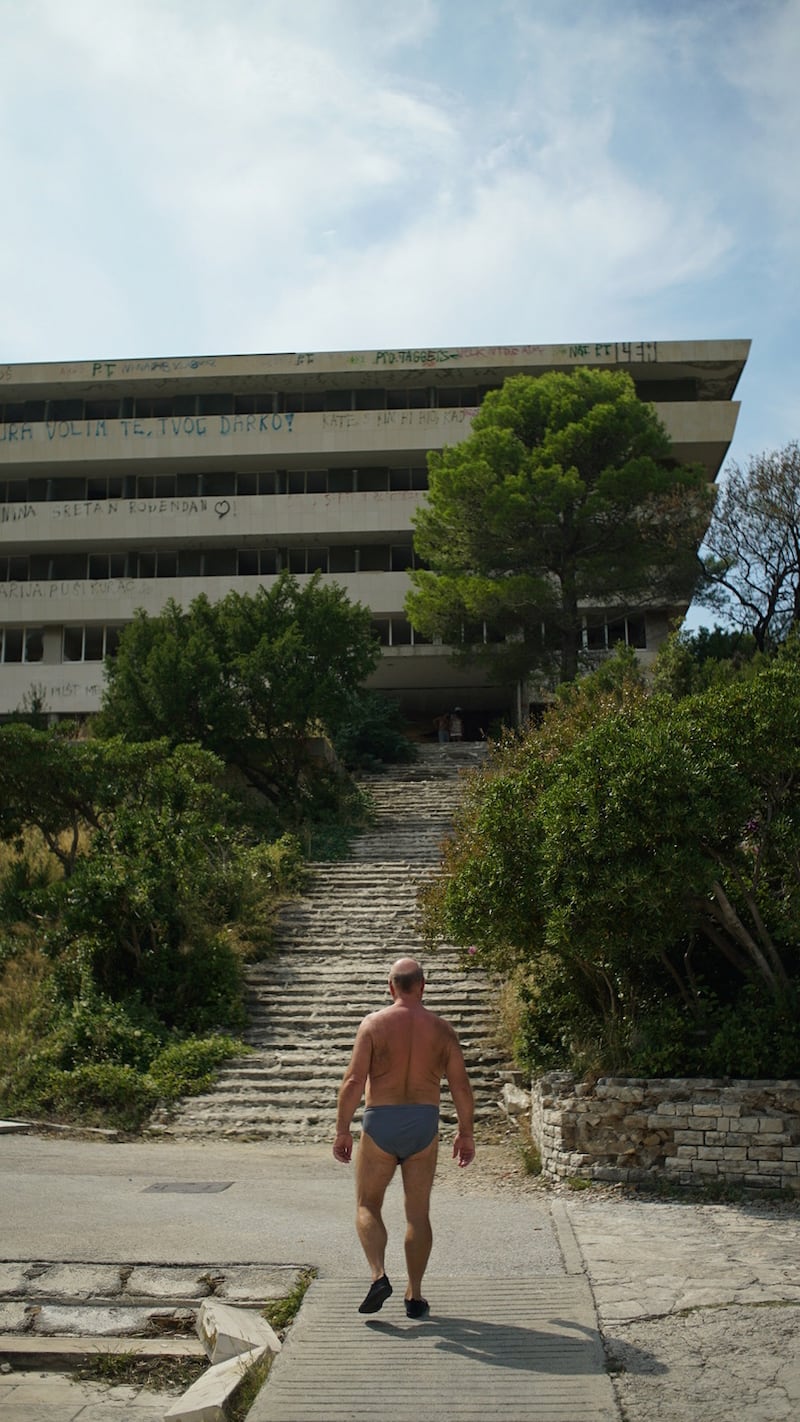
Twenty-eight years after it was first bombed, Hotel Pelegrin still lies in ruins. Once one of the most desirable resorts on the Adriatic Sea, its site, Kupari, was destroyed over 20 days in 1991, during the Croatian War of Independence.
Close to a million buildings in the former Yugoslavia had also been devastated 50 years before, during the second World War. Attempts at shaping a new, postwar future were explored during the 1958 programme of the League of Communists of Yugoslavia, at which it was declared that “nothing that has been created so far should be so sacred that it cannot be overcome, that it cannot be replaced with something more progressive, more liberated, more humane”.
This picture shows a tourist setting off to explore the ruins of Hotel Pelegrin, and of an entire social, architectural and political experiment
This led to a series of architectural projects, the first of which was the Pelegrin. David Finci’s design couldn’t have been more different from the edifices of mass tourism going up elsewhere along the Mediterranean coast.
Three years after finishing the Pelegrin, Finci moved to New York, where he continued working until the turn of the century. In a 2015 interview he said he still regarded the Pelegrin as his greatest achievement and believed that it could be saved.
Earlier that year, calls by Croatian architects to preserve the building had been rejected by the country’s minister for culture, and the building’s future was extinguished.
Finci died in 2017 in Sonoma, California. News of his death was not published in any regional or national media.
The Pelegrin, together with four other hotels in the surrounding resort, were purchased in 2015 by a Russian oligarch, Sergej Gljadelkin, and building permits are in the process of being finalised.
This picture shows a tourist setting off to explore the ruins of the Pelegrin, and of an entire social, architectural and political experiment.
LAURA HUTTON
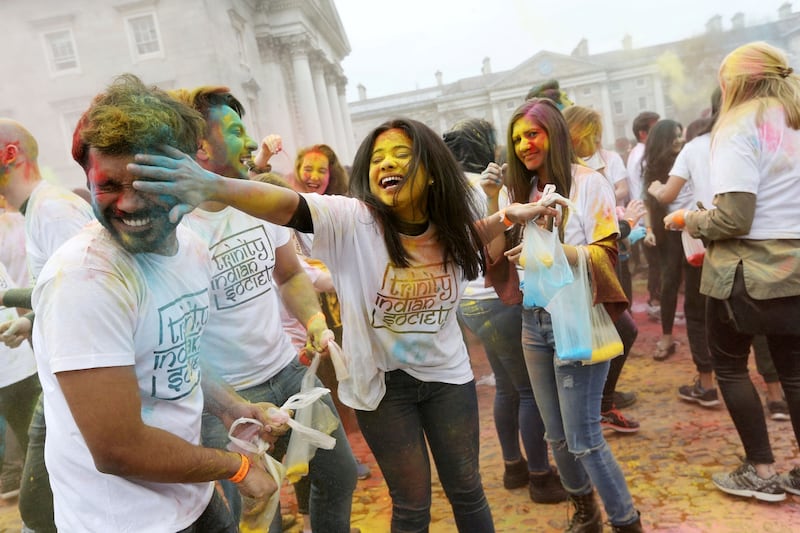
I’d always wanted to photograph Holi, the festival of colours that marks the beginning of spring in the Hindu calendar. It looked like great fun, and always made for good pictures. Over the years, scheduling didn’t allow, and I would envy photographers I met after it, covered in multicoloured powder, and giving out that the powder was now stuck in their camera gear.
This year, my first working at The Irish Times, the schedules aligned and I got to go to the celebrations at Trinity College Dublin. I watched as my intrepid colleague Enda O’Dowd wrapped his video camera in cling film, as did another photographer. I figured I’d be grand. I usually prefer to stand back from the action and pick it off on a longer lens; getting in close on a wide angle invariably leads to people performing for the camera. So I’d shoot it mostly on a 70-200mm, and grab a wider GV – or general view – from a height.
My longer lens was failing to capture the joy of the event, which was what it was all about. So as the last bags of powder were thrown into the crowd, I threw myself in and managed to grab this shot
The festival lasts about 45 minutes, but the best pics are always at the end, when everyone is covered in bright powder. This provides time to scout out a good spot to shoot and cover lots of angles. For the first throws I got on top of a table for a wide-angle GV, then worked my way around the taped-off area in Front Square, picking off action shots as they happened.
But it wasn’t working. The longer lens makes the shot cleaner by throwing out the background, but it was failing to capture the joy of the event, which was what it was all about. So as the last bags of powder were thrown into the crowd, I threw myself in and managed to grab this shot.
After filing the pictures, dusting myself off as best I could and thanking the Hindu gods I wasn’t being sent to Government Buildings looking like a walking rainbow, I found myself on my next job complaining to a colleague that the powder is almost as bad as sand for the camera. He hadn’t covered Holi, but he gave me the raised eyebrows I deserved.
The picture gave me my first front page since starting with the paper.
You can buy copies of these and other Irish Times images here










